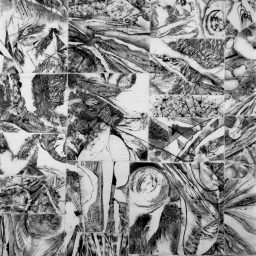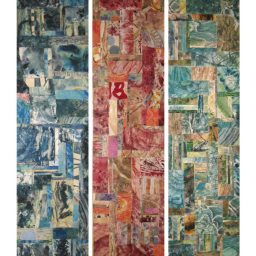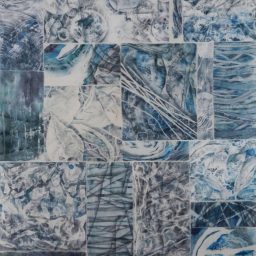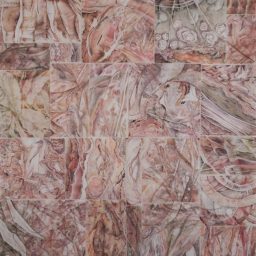Luigia d'Alfonso and Ada Perla after following individual paths with the aim of developing a personal creative process, decided in 2002 to share a studio, and their daily relationship stimulated them to start a new adventure together: a four-hand project. The dialogue, fertile ground of their work, has shaped a conceptual construction whose origin is in the surname that binds them, Perla, conjugal for one and family for the other. The research on the pearl, with studies and readings on its symbolic meaning in different cultures and civilizations, on mythology, on biological life, has connected their respective aesthetic and existential experiences. The image has slowly changed from an exogenous element to an inner suggestion and has opened the channel for a new communication. The osmosis between the two personalities, generated by this new path, has allowed the authors to reach a common language, the Sabìr. Tattered canvases painted and reassembled on thin gauzes. Nevertheless, they are strong enough to overcome a long journey, strong enough to weave a tale that crosses the Mediterranean. A weave of signs, threads and stratifications, recreates through the color the polyphonic dialogue between the cultures that border on it. Chosen in allusion to the ancient language of brokerage once spoken in the Mediterranean harbors, Sabìr was a free, unwritten language, which was continually reinvented; a language that was fragmentary, mingled, and patched together. Dialogue, the capability of interaction, the will to reach further away is a characteristic of the people living on the shores of this millenary sea, once linked by a common language and today separated by apparently unbridgeable cultural differences. But the will to communicate has the power to bring Sabìr back to life as a universal language.
The creative process of the artistic duo dap does not include preparatory sketches but individual thematic explorations that come together, through dialogue and interaction, in a common and unique visual language, which becomes concrete in their four-hand work. The experimentation of different pictorial techniques, a delicate and challenging step, has been essential to achieve the expressive harmony between the artists and create a correspondence between concept and language. The pictorial stratification on dismissed fabrics that still store the time thickness of their past, starts from a careful choice of colors. The unique "mixed" technique that the artists have developed, which is in harmony with the concept of a visual "oral storytelling", is fundamental in the phase of color layering because the absorption is immediate and this implies not only the fascination of an intentional representation, but also the acceptance of every single unintentional brush stroke that the fabric takes over as if it had its own soul. In dealing with the white cloth, a silent empathy is established through painting by tuning the different tones into a single story, the "canvas". A complete but open story that will then lead to the next, sometimes seamlessly, sometimes in contrast, sometimes by magic. The organic composition of the Sabìr and at the same time the valorization of the single "canvas" require an elaborate and complex analysis that parallels the pictorial action. From the table to the floor and to the wall, the work and the artists move in the continuous check of the story that unfolds and will only reveal its full appearance with the work of binding. The long and delicate assemblage is carried out with intangible gauzes, to complete the void left by the "missing words". Not all the canvases are employed: as in an assembling room, the final "frames" are cut, juxtaposed, twisted and tested again until they come together again to form a unicum, a journey without breaks, like a long film sequencing plan.
If Sabír are the plots of the main speech, the Totem are words left suspended. Tatters of painted fabrics deliberately left aside, poetically and rhythmically recomposed, according to the game of alliteration and semantic shifts belonging to the rhyming scheme. In the Italian tradition, the nursery rhyme (fila la seta) is deeply rooted and evokes a past world where wise old women and healers gave it a ritual value with magical and propitious powers. The fragments of the fabrics left over from Sabìr and Totem, which are collected along the way, are combined with a playful spirit in the Ciaccerata... chattering in the streets, confidences on the doorstep, the market shouts, whispers, mutterings...
The technical choices are part of the Sabìr concept. Use of dismissed fabrics, woven with natural threads such as cotton, linen and silk. Sheets, tablecloths, curtains, recovered from old trousseaus already worn out by experience, are tattered in the conceived sizes for the final composition of the work. Use of professional colors for textiles: the selected colors and tones are made by mixing concentrated pigments with a soft and transparent base and water, and by adding a catalyst that increases the polymerization. The mixed technique affords a heterogeneity of signs meant to represent singularity in multiplicity. And like the spoken word, the sign drawn on the fabric cannot be taken back, as the used colors dye immediately. Use of gauze: after several experiments, the gauze, tenacious but invisible, handled and cut in the right sizes, was chosen to bind the composition and restore the kaleidoscopic representation of a collective narration.
The language sabìr comes from the Spanish saber "to know" and was the common language used from Thessaloniki to Istanbul, from Valencia to Cagliari, from Genoa to Tangier. The latest studies define it as the most known long-lasting language. A poor but specific lexicon, with some categories of words missing, composed by Sicilian, Genoese, Venetian, Spanish expressions, with Arabic, Greek, Portuguese and Turkish elements. The grammar was simple, and the word order was quite free.
2022
RAW Rome Art Week, “Monochromacolor^, Group exhibition, Studio Campo Boario, Rome - Italy
In Scena!, In Scena! Award, Career Awards realized by dap, Italian Institute of Culture, New York – USA.
dap, “Sabìr limitless journey”, Solo exhibition, Time Gallery, New York - USA.
2021-2022
XXXIII Porticato Gaetano, “Environmental Emergency”, Group exhibition, Museum Pinacoteca Comunale A. Sapone, Gaeta – Italy.
2021
RAW Rome Art Week, “Flowery Room”, Group exhibition, Caterina Volpicelli Institute, Rome - Italy.
AUSGANG24, “GEHÄUSE”, Group exhibition, Incinque Open Art Monti Gallery, Rome - Italy.
2020
SHE IS, “SHE IS... 2020”, Group exhibition, One Art Space Gallery, New York - USA.
2019
Sinergie Solidali, "Woman: from Object to Subject", Group exhibition, Association seat, Rome - Italy.
RAW Rome Art Week, “Ciaccerata immaginatopeica”, a participated artistic project, INMI L. Spallanzani, Rome - Italy. "Ciaccerata... at Spallanzani", the donated work is exhibited in the hospital lobby.
ASREA, “ASREA 2019”, Group exhibition, Ex Cartiera Latina - Nagasawa Hall, Rome - Italy.
dap, "Sabir - Visionary bridge", Solo exhibition, One Art Space Gallery, New York - USA.
2018
XXX Porticato Gaetano, “The space and the time of memory”, Group exhibition, Museum Pinacoteca Comunale A. Sapone, Gaeta - Italy. Certificate of special mention. The work, "TMS", is now part of the contemporary art collection of the Pinacoteca.
Arte Laguna Prize 2018-19, Venice International contemporary art competition: Sabìr "Repercussions" overcame the first stage of selection.
Umbria Art, “Umbria Art Festival”, Group exhibition, urban location, Terni - Italy.
dap, "Sabìr pictorial plots", Solo exhibition, Pagea Contemporary Art Gallery, Angri - Italy.
Video

Events at Rome Art Week
2022
Free access
Vernissage Monday 24 Oct 2022 | 17:30-20:30
2021
Free access
Vernissage Monday 25 Oct 2021 | 16:30-19:00
2019
Free access









